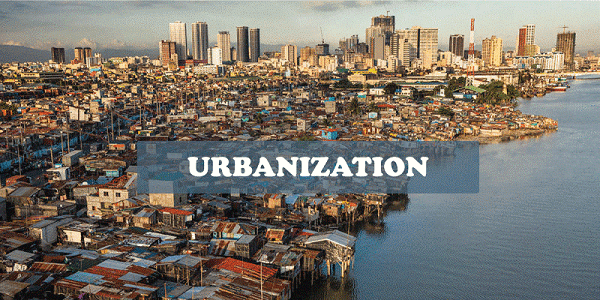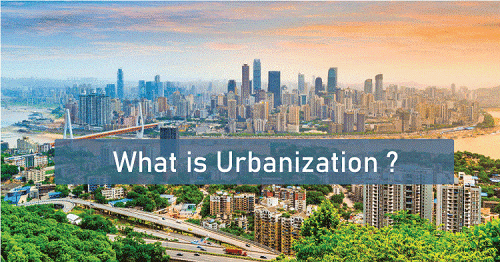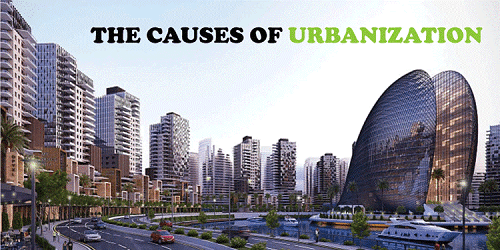Urbanization DefinitionOverview:Nowadays, more than 50 per cent of the world's population resides in cities, many of which are growing in population density. Nonetheless, in terms of human history, urban environments are a comparatively recent phenomenon. This change has altered the way we work, travel, live, and establish networks. This item provides a global overview of urbanization, including the distant past, the present, and predictions for the future. 
Although all industrialized nations have gone through urbanization at some point in their history, it is common for discussions of urbanization to focus on the nations that are now industrializing and urbanizing. In addition, urbanization is growing globally. The advent of the megacity, or a city with more than 10 million residents, is one result of this enormous growth in the number of people living in metropolitan regions. Cities today contain far more than that. For instance, Tokyo, Japan, is home to around 40 million people. Urban sprawl is another result of urbanization. As cities grow, they frequently start to occupy substantial swaths of land that were once used for agriculture because of this transition from higher-density urban centers to lower-density suburbs. The requirement for transportation infrastructure, such as highways, is also increased by sprawl because people's homes are likely to be located further from their places of employment and favorite amenities. The population of the entire world is probably going to keep expanding as the twenty-first century goes on. The population will continue to increase in urban regions. We face difficult problems as we get ready for the cities of the future because of this ongoing growth. For many years to come, the way we choose to handle urbanization will have an impact on the world. The notion of what makes up a city varies throughout time and geographically, although it is most frequently explained in terms of demography. The term "urban" is not defined by the United Nations; rather, it is referred to according to national definitions, which might vary greatly. What is Urbanization?Urbanization is the process by which cities develop and a rising proportion of the population moves there to live. The term "urbanization" describes the concentration of people in specific geographic areas. The land is transformed for residential, commercial, industrial, and transportation uses as a result of this concentration. 
Over time, human populations tend to rise. Little groups of people found reasons to band together to create groups as more people were born, and with the introduction of agriculture, small sedentary communities. A few of these communities developed into what are today known as cities. This kind of development frequently coincides with a change in the mode of labor organization. Urbanization is not just a contemporary phenomenon; it is a historic, rapid alteration of human social roots on a worldwide scale, where primarily rural culture is being swiftly replaced by predominantly urban culture. The first significant alteration in settlement patterns occurred when hunter-gatherers began to congregate in communities thousands of years ago. In the coming decades, it is expected that this tremendous human migration to cities will continue and accelerate, enlarging cities to proportions that were unimaginable a century ago. The global urban population growth curve thus followed a quadratic-hyperbolic trend up until recently. It is used to describe the population shift from rural to urban areas, the resulting drop in the number of people living in rural areas, and the methods by which societies adjust to this transition. It is primarily the process by which towns and cities are created and enlarged as more people move into urban centers to live and work. A Look Back at UrbanisationDespite the precise definition, it is evident that rapid urbanisation has been a feature of human history. Almost 50% of the world's population lived in urban areas as of the early 21st century. Old World and New World ancient civilizations' small villages were only made feasible by advancements in farming and transport. A surplus of food was created as agriculture became more productive. Since the wheel was invented, transportation technology has advanced, enabling the rural surplus to feed urban populations?a practise that is still practised today. Even though these communities were small, residents of early towns lived close to one another. No one could live farther than a short walk from the water source, and distances could not be larger than that. Moreover, cities were frequently walled due to the continual threat of assault, making it challenging to build obstacles that covered a vast area. Reasons for Urbanisation:Urbanization happens naturally or on purpose because of individual, group, and governmental actions. Residing in an urban area can be advantageous from an economic and cultural standpoint because it can increase employment prospects, improve living and safety standards, and cut down on travel time and costs. 
Urbanization has occurred, among other things, because urban areas now have superior political, financial, and social circumstances than rural ones. The reasons for urbanisation are listed below with a brief overview.
Urbanization's Impacts on Our Cities:i) Residential Issues:Cities and towns experience a significant population rise as a result of urbanization's draw. The number of individuals residing in metropolitan areas is rising, contributing to the ongoing housing shortage. This is brought on by a lack of expanding areas for housing and public amenities, as well as poverty, unemployment, and expensive building materials that only a select few people can afford. ii) Unemployment:Urban regions are where the problem of unemployment is most severe, and educated individuals are considerably more at risk. According to estimates, over half of the young people without jobs live in major cities. And even though urban locations have high wages, the high cost of living makes those incomes feel dreadfully low. The main contributor to urban unemployment is the growing emigration of individuals from rural or emerging areas. iii) Overcrowding:A scenario known as overcrowding occurs when many people live in a limited area. Urban regions consistently experience this type of congestion due to overcrowding, and it is a problem that becomes worse every day as more people, including immigrants, move there in pursuit of a better living. Most residents of rural or underdeveloped areas constantly feel the impulse to move to the city, which typically results in a concentration of people in a small area. iv) Construction of Slums:In cities, living expenses are very expensive. Slums and squatter communities, which are examples of illegal resident settlements, are on the rise as a result of this including random and unanticipated expansion, and unemployment. Rapid industrialization, a lack of built land for housing, a big migration of rural immigrants to the cities in quest of a better living, and the high prices of land that are out of the reach of the urban poor all contribute to the creation of slums and squatters in metropolitan areas. v) Issues with Water and Sanitation:It is typical to discover insufficient sewage infrastructure in most metropolitan places due to overcrowding and rapid population growth. The administration of sewage facilities is severely resource-constrained for municipalities and local governments. As a result, sewage flows in an erratic manner and is discharged into nearby streams, rivers, lakes, and seas. Eventually, contagious illnesses like typhoid, diarrhoea, plague, and diarrhoea spread quickly and caused suffering and occasionally fatalities. Water scarcity is also greatly influenced by overpopulation because supply cannot keep up with demand. vi) Congested Traffic:One of the biggest problems that the transportation system faces as more people relocate to cities and towns is congestion. When there are more people, there are also more vehicles, which causes traffic jams and vehicle pollution. Urban locations with a high percentage of commuters have severe traffic issues, particularly during rush hours. In addition, when cities expand in size, more people will go there to buy and fulfil other social demands and wants, which frequently leads to traffic jams and obstructions. Disadvantages of UrbanizationUrbanization yields several positive effects if it happens within the appropriate limits. Some of its major benefits include the creation of employment opportunities, technological and infrastructural advancements, better transportation and communication, and improved standards of living. However, extensive urbanization mostly results in adverse effects. Below listed points are a few of them. i) Higher Crime Rates:Issues of lack of resources, overcrowding, unemployment, poverty, and lack of social services and education habitually lead to many social problems including violence, drug abuse, and crime. Most of the crimes such as murder, rape, kidnapping, riots, assault, theft, robbery, and hijacking are reported to be more prominent in urban vicinities. Besides, poverty-related crimes are the highest in fast-growing urban regions. These acts of urban crime normally upset the peace and tranquillity of cities/towns. ii) Unhealthy Conditions and Disease Outbreaks:The social, economic, and living circumstances in crowded urban regions have an impact on who can access and use public medical facilities. Slum people are typically more susceptible to infectious diseases because of inadequate sanitation and inadequate water supplies, which are common in slum communities. Environmental issues like urban pollution contribute to several health issues, including infections, allergies, infertility, food poisoning, cancer, and even early demise. Urbanization Solutionsi) Delivering Crucial Services:Urban stakeholders are responsible for ensuring that all residents have access to the necessities of life, including food, technology, clean water, sanitation, and education. The goal is to create and implement wealth-creating chances and job opportunities so that people may make a living and pay for the upkeep of the services. The government can also use subsidies to reduce the cost of electricity, education, public transit, technology, and basic healthcare and education. ii) More Employment Creation:To lessen the negative effects of rapid urbanization while at same time conserving natural ecosystems, private investments should be encouraged to utilize natural resources and create more job opportunities. Tourism promotion and the sustainable exploitation of natural resources can create more jobs for urban populations. Subsidies and grants may as well be provided to foreign and private investment in environment-friendly projects that encourage job creation. iii) Population Management:To slow down the rapid rates of population increase, key stakeholders in metropolitan regions must run campaigns and offer counselling for efficient medical clinics and family planning. In order to control diseases and population increase, family planning-focused medical clinics must be made available throughout the entire urban region. Iv) Creating Environmentally Friendly and Sustainable Cities:As people should not live in dangerous or polluting locations, governments should enact laws that design and supply ecologically responsible cities and wise growth strategies. The goal is to create sustainable cities that aim to provide better environment and secure homes for all urban residents. Governments should promote the efficient use of urban resources as well as an economy based on environmentally friendly practises, such as investing in green public transit, conservation of natural resources, control of pollution, and more. ConclusionUrbanization is a sign of progress and development. However, it also causes some issues like crowded cities, traffic jams, high cost of living, and more. Overall, it is a positive change if it is managed properly using proper strategies and management by the government.
Next TopicPolitics Definition
|
 For Videos Join Our Youtube Channel: Join Now
For Videos Join Our Youtube Channel: Join Now
Feedback
- Send your Feedback to [email protected]
Help Others, Please Share










